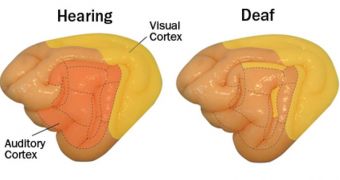Scientists say that people who are deaf may experience an improvement in their sight, as the brain rewires itself to compensate for the lost sensation.
According to a new study conducted on unsuspecting cats, it may be that the auditory cortex, the portion of the brain responsible for creating the sensation of hearing, changes when people go deaf.
Researchers say that this process happens so that the brain can enhance sight. In deaf people, a significant portion of the auditory cortex becomes involved in processing visual stimuli.
Details of the new investigation appear in a scientific paper published online in the October 12 issue of the esteemed scientific journal Nature Neuroscience, Science News reports.
Most commonly, scientists say, deaf people have superior peripheral vision and motion detection when compared to their peers who can hear.
But, until now, the cortical mechanisms that enable these advantages were not well studied. This study sheds some light on the complex interactions that underlie the keener vision of deaf individuals.
“Over the years, we’ve [only] speculated about how these changes might be taking place,” explains Helen Neville, a neuroscientist at the University of Oregon in Eugene.
The new investigation, which was led by researcher Stephen Lomber, is the first to establish how regions of the auditory cortex are co-opted to enhance visual sensations.
“There have been all these theories out there for what region of the brain might be responsible for this, but no one has actually gone in there and demonstrated it,” Lomber explains.
He adds that the research was conducted on cats because these animals have brains that are organized very much like our own from this point of view.
The scientist goes on to say that deaf cats don't necessarily see well than their hearing peers. Instead, they are more adapt at detecting very slow motion. They also have better peripheral vision.
“You can’t hear the dog running or the car coming at you, so being able to see it seems like a really good skill,” Lomber argues.
The expert is based at the University of Western Ontario in London, Canada. Using a particular type of cooling device, the research team inactivated parts of the auditory cortex in deaf cats, and saw the animals lose their special skills.
“What we found was, much to our surprise, that these functions were not distributed randomly over the auditory cortex, but they were specifically localized in particular places,” the team leader says.
“It seems that if there’s no auditory stimulation, the auditory cortex was still doing what it would normally do, but with a different sensory input – in this case, vision,” Lomber concludes.

 14 DAY TRIAL //
14 DAY TRIAL //